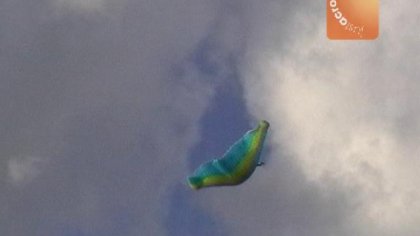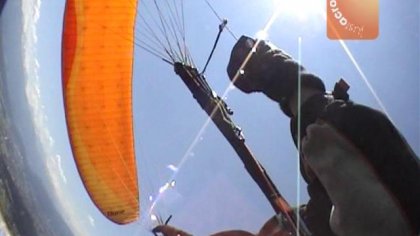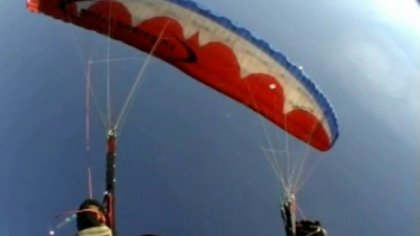19 years ago
Description:
This trick was invented by Raul Rodriguez in 2001. It’s a SAT, leaded in from a Looping. At this moment this is the most powerful manouvre, whilst the G-Force could reach more than 6 G (The danger of losing the vision [„seeing grey”] is possible from 4.1 G, but actually not by a short loading like this). The movement is very similar to the Asymmetric SAT, but the axle of the rotation can be so high, that the pilot passes above the middle of the glider.
Enter:
In the following text I describe a Tumbling to the left:
Start an impressive Asymmetric Spiral to the right. When you have LOT’S of energy, pull a SAT to the left with extremely weight shifting, just at the same moment, you would do the Looping. Than just keep the brakes and enjoy the effect of the high G-Forces…
(When you do an Asymmetric Spiral to the right, and pull a SAT to the right, that would be an Asymmetric SAT, if you pull a SAT to the left (in a Looping) that’s a Tumbling)
Or
You can also enter a Tumbling from a big Wing-Over with the same technique, but I advise you to try the first way, because there’s more energy in Asymmetric Spirals, so it’s much safer! Keep in mind: dynamic = safety!
The most important thing is take enough energy for the enter. With some dynamic acro gliders it’s possible to do nice Tumblings just after 2-3 Wing-Over turns, but with „serial” gliders it’s usually necessary to build up a well timed and really dynamic Asymmetric Spiral to have enough energy to finish the second turn safe. Try the following technique if you need more energy:
Enter a clear deep spiral by braking and weight shifting. Take care not to get a tip collapse on the outside, bacause you loose energy. However if it happens reopen it it and wait until the spiral stabilizes again. After 1-2 turns when the leading edge starts to be facing to the ground and you have quite a lot of speed already, quickly release the brake and shift your weight to the outside, just as you would lead out the spiral very fast to swing down straight under the glider. But before you reach the lowest point with lot’s of speed, start an impressive asymmetric turn to the same side, much earlier as you do it in a normal Asymmetric Spiral. The following turn will be really dynamic but asymmetric, so it’s very good to enter a Tumbling from. To enter the Tumbling you have to start weight shifting quite early, after passing the highest point, than pull the brake just before or on the lowest point.
Advanced technique:
If you just keep the brake locked, with some gliders the second turn will be higher but slower than the first. When the pilot is above the glider in the second turn, the energy is on it’s lowest, until the pilot passes trough. Because the brake is pulled very hard, during these moments the glider turns a little bit steeper in the SAT (except this period the brake is too heavy and it cannot happens because of the high tension and speed). By this the second turn will be more vertical, but with less energy.
If you want to prevent this angle change you have to release the brake a little bit on the top of the second turn.
If you want to keep the height and the energy of the first turn do the same on the top of the first turn as well (by releasing the brake the glider shoots forward faster so it gets more energy). In this case pull back the brake at the moment the glider starts to shoot below and you experience the highest G-Force. You can see this technique working in the Tumbling video clip.
Exit:
Lead out the Tumbling by braking the glider when it starts to „dive” again, just like in Asymmetric SAT. If the remaining energy is considerable, you should brake the glider pretty hard to stop the glider otherwise you will get a huge collapse and free fall down next to, or into the canopy! At the exit the glider (especially with high aspect ratio) could get a shape „U” while it’s in front of you, due to the forceful braking.
If there’s less energy at the end, you may have to perform a Full Stall when you swing back under the glider to return normal flight.
Just as in Asymmetric SAT, the right timing of the exit is the most important thing ever (that’s why it’s necessary to know the Asymmetric SAT very well before you try this trick)! With a serial glider it’s possible to do 2 times tumbles safe. The best acro pilots can do 3 or maybe 4 tumble turns with dynamic acro wings, but that’s more like a Rhythmic SAT than a Tumbling. I strongly advise to exit the Tumbling after 2 turns, exept if your technique is advanced and you are absolutely sure there’s enough energy to do the next loop.
Advanced technique:
Usually the glider shoots forward very violently and asymmetrically (much more radical than in the Asymmetric SAT!), so it’s hard to stop and you can easily get very big collapses on the lower (outer) side. To make the surge more symmetrical, try the following technique:
Release the inner brake (left in our case) a little bit in the second turn, when the glider is above you (you see the sky behind). Wait just a moment, than start braking only with the right side and only than pull the left also.
In a left Tumbling the left side is higher, so if you release that brake, and than pull the right first, the leading edge will turn to be facing to the horizon (because the left side accelerates) and it’s an easier and safer situation to stop the glider.
Dangers!
All dangers of Asymmetric SAT and even much more, because if you try to do another loop without enough energy you can easily fall into the canopy. Also be prepared for the massive impact of high G-Forces!
Because of the big pendulum it’s more difficult to pull a negative at the enter, but be careful not to do a big MacTwist unintented!
During this manouvre the glider is under extremely increased loading. Make sure your glider’s condition is good enough to stand out these high G’s, otherwise the lines and even some parts of the canopy can break! It’s also not much fun if your brakeline gone in the middle of the manouvre… In this case you manage to stabilize the glider, go to land as soon as possible using the „D” riser. If one of the „A” or „B” lines break, the loading on the rest will increases and many others will follow. If the canopy is not safely steerable anymore, don’t hesitate to throw your reserve!
As you can see this is a very complex manouvre (the combination of Asymmetric Spiral, Looping, SAT and others…), please do not try it, until you are really advanced with most of the acro manouvres.






!['dumblin' failure [petlu | acro | crew]](https://justacro.com/files/styles/video_large/public/media-vimeo/1276088.jpg?itok=blCJ9TYl)
Latest Comments
Exactly, as you say. But always make sure to gain enough speed before. The best is to master two kinds of asymmteric spiral first. One is when you swing up as high as possible (this is a nice asymm spiral), the other is when you make a more flat turn but with more speed (this speedy turn is what you need to switch to the next maneuver: looping, tumbling, asymm sat, mactwist...) Other important point is to control to arrive exactly under the center of your glider when you swing under from the last turn in the spiral. If you learn these things first it is more difficult to get into trouble during tumbling.
Good training!
Gabor
with tumbling is it similar to looping in that if u switch early its safe but not as extreme( not over the glider) and if u wait u have less energy and therefore its more dangerous but higher amplitude? thanks alex